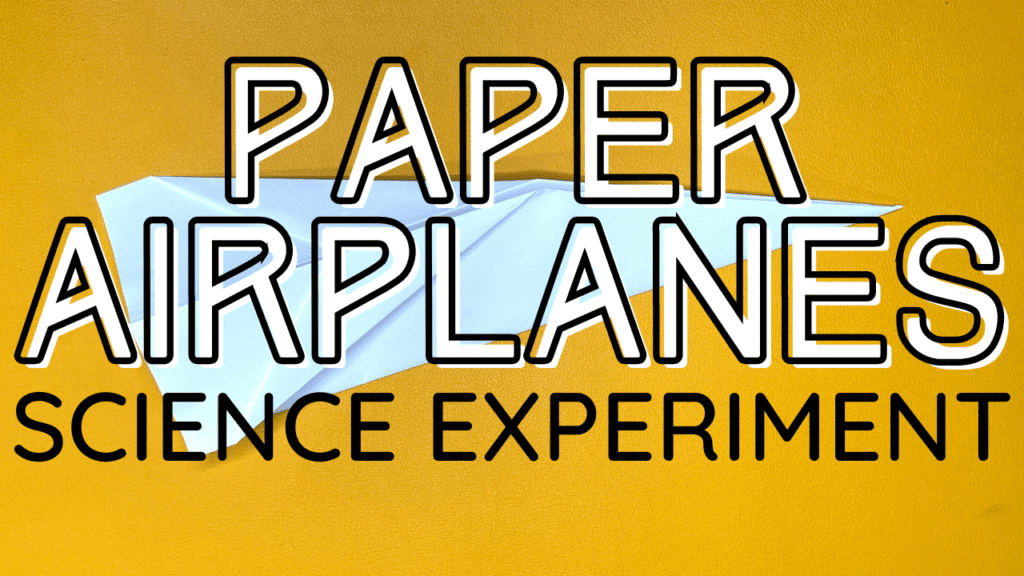Do you remember folding and flying paper airplanes when you were a child? It turns out that they’re not only fun, but can be a great teaching experience for your child.
Building paper airplanes with your child helps them to understand simple principles of aerodynamics, like what makes a plane fly and what can affect the flight. It also helps with the concept of distance, since you can measure how far each paper airplane flies during your experiment.
I know it sounds a little intimidating to teach your child about aerodynamics, but these concepts are very basic and I walk you through the entire thing below!

How to make the Paper Airplanes experiment
Supplies you will need
For the paper airplane experiment, you’ll need:
- 3 sheets of printer paper
If you want a fancier paper airplane, here is a fun website that allows you to customize your paper airplanes and print them out!
that allows you to customize your paper airplanes and print them out!
Before you start
Although I do walk you through the steps of making 3 different paper airplanes, I did gather these folds from a great site called Fold ‘N Fly. If you find these particular airplanes challenging, you may find a better fit for you on their site.
I do recommend choosing 2-3 different airplane folds so you can cover the science behind it by comparing the models. The 3 folds I cover here have varying wing lengths, and that’s what we will talk through in the “Science Behind It” section.
Instructions
Here is how to do the paper airplane experiment with your child:
Step 1: Fold 2-3 paper airplanes
I chose to do 3 paper airplane folds. I’ll link to each one on the Fold ‘N Fly site below, as well as include a quick video of me folding them.
“The Basic” – this is the paper airplane fold that most people first learn how to fold. Very easy to do!
“Basic Dart” – the next level up from the basic airplane fold. It’s sleeker and is supposed to travel farther.
“The Stable” – I hadn’t heard of this fold before, but it was easy to do and, like its name, is very stable and can fly far.
Get your preschooler involved: If your child is able to do simple folds, allow them to make the first couple of folds on each paper airplane. If not, then start the fold and let them press on the crease.
(Optional) Step 2: Create a runway to track the flying distance of each airplane
I chose to use painter’s tape on the carpet for this step. Just stick a few lines of tape on the carpet before flying your airplanes and see which went the farthest!
Get your preschooler involved: Let them fly the plane! Show them how to hold it properly and how much force to throw it with and see how far they can throw it. If you have extra paper, create an extra airplane of each fold so you can compete!
The science behind the Paper Airplanes experiment
Teaching your child about aerodynamics is a lot more fun when they get to build and fly airplanes. This experiment does just that: testing out different airplanes, asking questions about why and what makes them fly further, and flying them to find the answers!
In our experiment, we test out 3 different airplanes of varying wing lengths and bodies. This allows us to answer important questions about flying airplanes:
- Which model of airplane will fly farther? One with a shorter or longer wingspan?
- Does the length of the airplane affect anything?
- Which model allows us to fly higher? Perform spins? Fly further? Fly more controlled?
While you’re running the experiment with your child, compare the wingspans before flight, then test each one. It will help them to keep that information in mind while flying the airplanes.
How it works
There are several different forces at work that affect how far our paper airplanes will fly:
- Drag – resistance our airplanes encounter while moving through the air
- Thrust – the forward movement of the airplane, which is provided by us in this experiment
- Lift – the air below the airplane wings that help it keep flying
- Gravity – the force that pulls the airplane downward
The first and third folds, “Basic” and “The Stable” are considered gliders (although “Basic” is more of a hybrid between a dart and glider) and the second fold is a dart.
Gliders can utilize lift much better than darts due to their larger wingspan, although they cannot tolerate much thrust to get it started. Darts, on the other hand, can tolerate a large amount of thrust but cannot utilize lift as well.
While the larger wingspan does allow the gliders to have longer flight time, they do not technically fly the farthest distance. Darts, given their resiliency to a larger amount of thrust, allow them to fly farther and spend less time aloft.
More physics experiments to try out with your child
- Catapults – build a catapult and see what makes your objects fly farther!
- Sink or float – what is density and how do you know when something is denser than the liquid it’s in?
FAQ about the Paper Airplanes Experiment
What makes a paper airplane fly farther?
When it comes to distance, dart paper airplanes tend to fly farther than a glider. This is due to the amount of thrust a dart can handle, giving it more power to fly farther.
